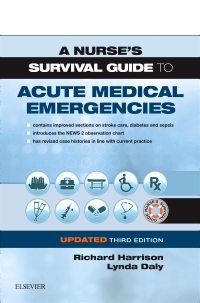
A Nurse's Survival Guide to Acute Medical Emergencies Updated Edition Elsevier eBook on Vitalsource, 3rd Edition
Elsevier eBook on VitalSource

-
Abbreviations
- Introduction: Immediate assessment of the critically ill
- Cardiology
- Respiratory medicine
- Acute neurological problems
- Gastroenterology
- Diabetic complications
- Thromboembolic disease
- Deliberate self-harm, alcohol and substance abuse
- The ‘social admission’
- Multisystem failure
ABCDE: Immediate assessment and intervention
Early warning: Track and Trigger
National Early Warning Score
Communication – NEWS and SBAR
Acute severe breathlessness
Cardiac failure
Heart muscle damage
Valvular disease
Rhythm disturbance
Types of heart failure
Left heart failure
Right heart failure
Congestive cardiac failure
Right heart failure and COPD
Diastolic heart failure
Clinical features and management of cardiac failure
Acute left ventricular failure
Acute on chronic congestive cardiac failure
Ischaemic heart disease
Chest pain
Acute coronary syndromes, NSTEMIs and Unstable Angina
Sudden cardiac death
Atrial fibrillation and arterial emboli
Causes of atrial fibrillation
Importance of atrial fibrillation
Complications of atrial fibrillation
Diagnosis of atrial fibrillation
Management of atrial fibrillation
Infective endocarditis
Drugs in the management of acute heart disease
The breathless patient: the general approach
Respiratory failure
Type I and Type II respiratory failure
Principles of treatment
Acute severe asthma
Mechanisms
Assessment of acute severe asthma
Management of acute severe asthma
Chronic obstructive pulmonary disease
Mechanisms
Management of acute exacerbations of COPD
Non-invasive ventilation
Pneumonia
Assessment
The severity score in pneumonia: CURB-65
Management of pneumonia
Antibiotics
Spontaneous pneumothorax
Nursing the patient with a chest drain
Ensuring the safety of the patient
Prioritising the initial management: GCS and ABCDE
Managing ‘medical’ and ‘neurological’ coma
Responding to neurological deterioration
Stroke and stroke-like emergencies
Cerebral infarction
Transient ischaemic attacks
Intracerebral haemorrhage
Subarachnoid haemorrhage
Subdural haemorrhage
Extradural haemorrhage
Nursing the patient with a stroke: the first 24 h
Meningococcal meningitis
Acute severe headache
Subarachnoid haemorrhage
Lumbar puncture
Sudden loss of consciousness: faints and fits
The basic mechanisms: syncope
The basic mechanisms: epileptic seizures
Pseudoseizures (non-epileptic seizures)
Acute paralysis of the lower limbs
Spinal cord compression
Guillain–Barré syndrome
Nausea and vomiting underlying mechanisms
Nausea and vomiting in acute medical conditions
Acute upper gastrointestinal haemorrhage
Management of upper gastrointestinal haemorrhage
Portal hypertension and the management of oesophageal varices
Acute liver failure and hepatic encephalopathy
Acute jaundice
Acute abdominal pain
Acute diarrhoea: sources and courses
Infective diarrhoea
Clostridium difficile diarrhoea
Infective diarrhoea versus acute ulcerative colitis
Medical conditions presenting with gastrointestinal symptoms
Diabetes on the Acute Medical Unit: the general approach
Normal blood sugar control and the nature of diabetes
An overview of Type I and Type II diabetes
Acute medical conditions associated with diabetes
Diabetic renal disease
Diabetic neuropathy
Cardiovascular disease
Cerebrovascular disease
Peripheral vascular disease
Blood sugar control in adverse medical situations
Variable Rate Intravenous Insulin Infusion (VRIII) or GKI
DIGAMI regimen
Diabetic Keto Acidosis (DKA)
Hyperosmolar non-ketotic diabetic coma (HONK)
Hypoglycaemia
Infective complications in diabetes: the acute diabetic foot
Thrombosis and thromboembolisation
Mechanisms
Superficial thrombophlebitis
Deep vein thrombosis
Pulmonary thromboembolism
Tests to identify thromboembolic disease
Management of pulmonary thromboembolism
Nursing the patient with a suspected DVT
Other causes of a swollen painful leg
Cellulitis
Necrotising fasciitis
Management of a DVT
Anticoagulation therapy
Deliberate self-harm
General principles
Care of the unconscious patient: ABCDE
The patient who refuses treatment
Specific overdoses
Benzodiazepines
Paracetamol poisoning
Antidepressant overdose
Carbon monoxide poisoning
Alcohol abuse
Acute alcohol-withdrawal syndrome
Cocaine 303 Ecstasy
Heroin abuse
Needle stick injuries
Hospital-acquired methicillin-resistant Staphylococcus aureus infections
Violent incidents
Common errors and omissions in the admission of elderly patients
Taking a history from the patient
Taking a history from a third party
Falls
The cause of falls
Assessment after a fall
Immobility
Immediate safety of the patient: ABCDE
Assessing the cause: establish the full history
Delirium
Dementia
Nursing home admissions
Ethical issues and the elderly sick
The emergency admission of patients with a terminal disease
Shock: the basic mechanisms
Cardiogenic shock
Hypovolaemic shock
Redistributive (low-resistance) shock
Acute severe hypotensive collapse
The importance of immediate resuscitation

 as described in our
as described in our 